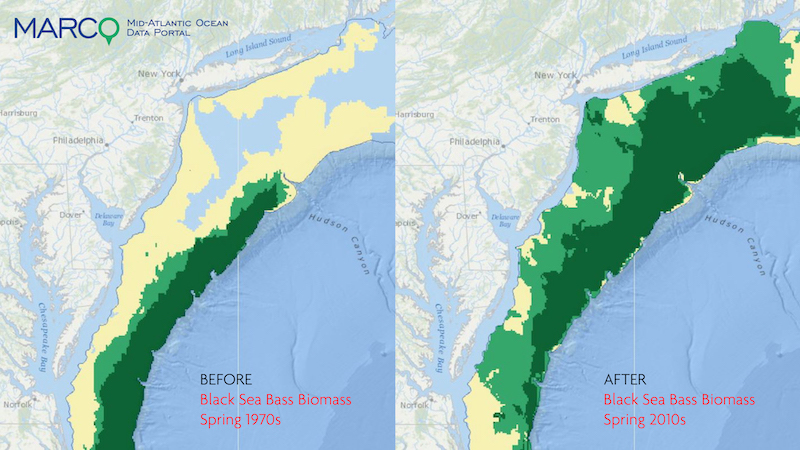A new series of interactive maps graphically portray long-term shifts in fish populations off the East Coast, as changing ocean temperatures push species like black sea bass northward.
Published through the online on the Mid-Atlantic Ocean Data Portal, the maps chart major change since the 1970s that have affected commercially and recreationally important finfish species living along the East Coast.
Using the free public-access portal at portal.midatlanticocean.org users can automatically animate or toggle through hundreds of maps representing fish distributions during the spring or fall seasons from the 1970s through 2019. The portal maintains 5,000 map layers that can superimpose data for commercial fishing hot spots, marine life habitats, zones being examined for offshore wind development and other ocean activities.
Many of the maps confirm trends seen by fishermen and biologists of species moving to waters farther north and farther offshore since the 1970s. Black sea bass have become a well-known example; once straying into southern New England waters, black sea bass have over the decades moved past Cape Cod to become established in the Gulf of Maine.
“Our analysis and the maps make no assumptions as to the factors causing these shifts,” said Chris Bruce, Global Information Systems manager at the Nature Conservancy in Virginia and a member of the portal technical team, in a statement. “However, there is no shortage of scientific research to refer to on how factors like climate change and increasing water temperatures are impacting marine habitats.”
The mapping effort covered alewife, American shad, Atlantic mackerel, black sea bass, blueback herring, bluefish, butterfish, longfin squid, monkfish, northern shortfin squid, red hake, sand lance, scup, spiny dogfish, spot, summer flounder, winter flounder and yellowtail flounder.
The analysis also yielded a pair of summary maps that illustrate shifts by demersal fish and forage fish, and overlap maps showing where fish were consistently present each decade.
The regional portal is a collaborative project of states thought the Mid-Atlantic Regional Council on the Ocean, established to help coordinate ocean planning between the states, federal government and other entities. The mapping project — titled Fish Species Through Time — was made possible by a grant from the Virginia Coastal Zone Management Program to the Nature Conservancy and created based on an analysis of federal Northeast Fisheries Science Center bottom trawl survey data collected between 1972 and 2017.
The portal also offers a forecast of how species shifts might continue to shift through the end of the 21st century, using animated maps based on data previously released by OceanAdapt, a collaboration between the Pinsky Lab of Rutgers University, NMFS, and Fisheries and Oceans Canada.
To access the maps, click on the Marine Life theme and then on the dropdowns for Fish Species Through Time (for the data showing the 1970s-present) or Fish Species Future Projections.
“These maps tell an important story about the challenges our region’s economies and communities face due to the rapid changes taking place in our ocean,” said Laura McKay, program manager with Virginia Coastal Zone Management and the chair of MARCO’s mapping and data team that manages the portal. “We hope that they help the region’s ocean stakeholders and decision-makers understand the trends so they can plan and adapt accordingly.”
The portal is maintained by a team consisting of the Monmouth University Urban Coast Institute, Ecotrust, the Nature Conservancy and Rutgers University’s Center for Remote Sensing and Spatial Analysis under the guidance of MARCO.







